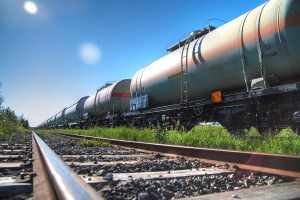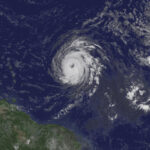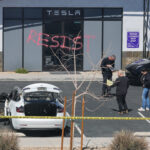The derailment and fire that led to the evacuation of a North Dakota town has renewed the debate over whether it’s safer to ship oil by rail or pipeline as the U.S. completes a review of the Keystone XL project.
“Any time there is an incident, you have heightened talk and scrutiny on oil transportation,” Brigham McCown, a former director of the Pipeline and Hazardous Materials Safety Administration, said yesterday in an interview. “It will add to the conversation.”
Public safety officials urged more than 2,000 North Dakota residents to flee fumes from the fire that engulfed BNSF Railway Co. cars carrying oil after a collision Dec. 30 with another train about 25 miles (40 kilometers) west of Fargo. BNSF is owned by Berkshire Hathaway Inc. of Omaha. The evacuation was lifted yesterday at 3 p.m. local time after health officials declared the air safe.
While climate change has been the focus of the fight over TransCanada Corp.’s proposed Keystone XL pipeline from Canada to the U.S. Gulf Coast, a subset in the debate has been the relative safety of pipes versus trains. The U.S. State Department, reviewing the $5.4 billion project because it would cross the U.S. border, is weighing whether the pipeline would be in the national interest.
Keystone would allow about 100,000 barrels a day of crude from the Bakken formation in Montana and North Dakota onto the pipeline through a link in Baker, Montana.
‘Increasing Scrutiny’
“Bakken oil is going to come under increasing scrutiny,” as a result of the rail explosion, said Robert Schulz, a professor at the University of Calgary’s Haskayne School of Business. “You may see additional thoughts of, ‘Let’s approve Keystone because it’s going to be safer.’”
The North Dakota accident is the fourth major North American derailment in six months by trains transporting crude. Record volumes of oil are moving by rail as production from North Dakota and Texas have pushed U.S. output to the most since 1988 and pipeline capacity has failed to keep up.
“I think this — seemingly yet another rail incident — will add to the clamor” for more regulation of shipping oil by rail, Tony Hatch, an independent rail analyst based in New York, said by e-mail.
Critics of Keystone have pointed to pipeline spills in Alabama, Michigan and North Dakota to show that method of transporting oil carries its own hazards. In September, a Tesoro Corp. pipeline ruptured and spilled 20,000 barrels of crude in northwest North Dakota.
Few Incidents
Even with recent events, McCown, who is now an industry consultant and a supporter of Keystone, said both trains and pipelines are safe, with few incidents relative to the amount of crude they transport. One advantage pipelines have is that they tend to be in more sparsely populated areas, he said.
“Rail built the West — rail built most of the towns,” he said by telephone. “As a consequence, there are more rail lines going through more populated areas.”
Anthony Swift, an attorney for the Natural Resources Defense Council, said the Dec. 30 derailment underscores the need to improve train safety in the U.S., regardless of whether Keystone gets built.
“Crude by rail is happening in North Dakota, it’s not related to Keystone,” Swift said in a telephone interview. “Keystone isn’t going to eliminate this crude-by-rail movement in the U.S.”
Carbon Emissions
The State Department review of Keystone’s environmental impact includes whether the pipeline would lead to more carbon- dioxide emissions. The analysis could be released in the next few weeks.
President Barack Obama said in a June speech on climate change that he wouldn’t approve Keystone if it would lead to a significant increase in carbon-dioxide emissions.
McCown said rail use would probably increase if Keystone were blocked. “The oil will find its way to market,” he said.
Critics of Keystone argue that oil sands development will stall if the pipeline, which would have a capacity to carry 830,000 barrels of crude, is blocked by the administration.
Michael Whatley, executive vice president of Consumer Energy Alliance, an industry-backed group that supports Keystone, said more rail accidents can be expected with the increased use of trains to carry oil to market.
“Trains need to be a supplement, not a replacement” for pipelines, Whatley said. While both forms of transportation are safe, “we need expanded pipeline infrastructure,” he said.
State Department
A draft supplemental environmental impact statement released by the State Department in March included a brief comparison of the safety of pipelines versus rail.
While derailments probably would release less oil than a pipeline rupture, trains have an “increased statistical likelihood of spills,” the report said.
The North Dakota crash is “a wake-up call for what increased oil production in North America is going to mean” for U.S. communities, said Stephen Kretzmann, executive director of Oil Change International, a Washington-based group that opposes the use of more fossil fuels.
Kretzmann said that while he expects advocates of the Keystone pipeline to use the train crash as evidence that rail transport is unsafe, pipelines also pose dangers.
The best solution “is to phase down oil production,” Kretzmann said.
Casselton Incident
The latest incident occurred when a westbound train carrying soybeans derailed west of Casselton, in eastern North Dakota, just after 2 p.m. local time Dec. 30, said Cecily Fong, a spokeswoman for the state Emergency Services Department. An eastbound train carrying oil hit the derailed train, causing the fire, she said. Nineteen cars carrying crude derailed, said Robert Sumwalt, a member of the U.S. National Transportation Safety Board who was dispatched to the scene.
The train carrying oil originated in Fryburg, North Dakota, and was bound for Hayti, Missouri, on the Mississippi River, Sumwalt told reporters in Fargo yesterday. Of the 106 rail-cars, 104 were carrying oil, he said.
Marquis Energy, based in Hennepin, Illinois, runs a terminal in Hayti that unloads crude from railcars and sends it by barge down the Mississippi, according to the company’s website. The complex handles seven unit trains a week through BNSF, the website shows.
Railcar Safety
Sumwalt said investigators hope to retrieve data from event recorders on the oil train’s rear locomotive. The team has also looked at the last 20 seconds of video taken from a camera on the oil train, which shows the collision.
 The oil tank cars were DOT-111 models not of a newer design, Sumwalt said. The safety board has urged the U.S. Pipeline and Hazardous Materials Safety Administration to issue tougher standards for such cars to make them more resistant to puncture during accidents.
The oil tank cars were DOT-111 models not of a newer design, Sumwalt said. The safety board has urged the U.S. Pipeline and Hazardous Materials Safety Administration to issue tougher standards for such cars to make them more resistant to puncture during accidents.
The pipeline agency is reviewing updates to its rules.
Two to three railcars were still burning yesterday morning and 1,500 residents living within a five-mile radius of Casselton heeded warnings to evacuate, Tara Morris, a spokeswoman for the Cass County Sheriff’s Office said at a press briefing. One tank car can hold about 700 barrels of oil, according to the Energy Information Administration, the Energy Department’s statistical arm.
No injuries to the train crews were reported, BNSF said in a statement.
“We are thankful there have been no injuries as a result of the derailment near Casselton, North Dakota, and are terribly sorry for the inconvenience this derailment has caused residents in the area,” the company said.
Debris Cleared
About 65 percent of the 2,400 residents of Casselton left their homes as BNSF crews cleaned up debris while waiting for fires in two or three rail cars to burn out, Morris said.
The train tracks closed after the Dec. 30 derailment are expected to reopen at 7 a.m. local time tomorrow, Fort Worth, Texas-based BNSF said in a notice on its website yesterday. The company, meanwhile, is rerouting trains through other parts of North Dakota, as well as South Dakota, Montana and Wyoming, according to the statement.
North Dakota Governor Jack Dalrymple, a Republican, and U.S. Senator John Hoeven, a Republican, met with BNSF Railway Chief Executive Officer Matthew Rose to express concern about the accident and call for ways to expedite rail-transportation safety, according to a statement posted on the governor’s website yesterday.
“We need to rigorously review which products can be shipped in which railcars for maximum safety until newer cars come online,” Senator Hoeven said in the statement. “We also need to advance rules for building new tankers with enhanced safety features.”
Daily Haul
Berkshire’s Burlington Northern Santa Fe railroad carried about 500,000 barrels of oil a day in March, Chief Executive Officer Warren Buffett said at the time.
Continental Resources Inc., the largest leaseholder in North Dakota’s Bakken shale field, projected “slight delays” in shipments for several days from the region due to the fire, spokesman Warren Henry said in a telephone interview.
Oil produced in North Dakota’s Bakken formation for delivery at Clearbrook, Minnesota, strengthened 75 cents a barrel to a discount of $7.50 a barrel versus U.S. benchmark West Texas Intermediate crude at 2:06 p.m. New York time, data compiled by Bloomberg show.
“We expect companies to use alternative routes for transportation by rail and do not anticipate the incident to have any short term impacts on production,” Lynn Helms, director of the North Dakota Department of Mineral Resources, said in a statement.
Earlier Accidents
In November, a train carrying oil to the Gulf Coast from North Dakota derailed in Alabama, touching off fires. A month earlier, residents were evacuated from a rural area of Alberta after 13 railcars, four of which were carrying crude, derailed and ignited a blaze.
In July, a runaway train transporting crude exploded and killed 47 people in the Quebec town of Lac-Megantic.
The Dec. 30 derailment “is likely to flare up the debate on the environmental side of the shale oil boom, which could result in higher costs for the industry,” JBC Energy GmbH, a Vienna-based energy consultant, said in an e-mailed report yesterday.
(With assistance from Lucia Kassai and Barbara Powell in Houston, David Stringer in Melbourne, Edward Welsch in Calgary, Konstantin Rozhnov in London and Brian Wingfield, Angela Greiling Keane and Alan Levin in Washington, and Edward Johnson in Sydney. Editors: Jon Morgan, Robin Meszoly, Pete Young.)
Was this article valuable?
Here are more articles you may enjoy.

 Teen’s Suicide Turns Mother Against Google, AI Chatbot Startup
Teen’s Suicide Turns Mother Against Google, AI Chatbot Startup  Alibaba Teams up With BMW to Develop AI for Cars in China
Alibaba Teams up With BMW to Develop AI for Cars in China  An Unusually Active Hurricane Season Is in Store for the Atlantic
An Unusually Active Hurricane Season Is in Store for the Atlantic  Tesla Showroom Strikes, Vandalism Sparked by Fury Against Musk
Tesla Showroom Strikes, Vandalism Sparked by Fury Against Musk 